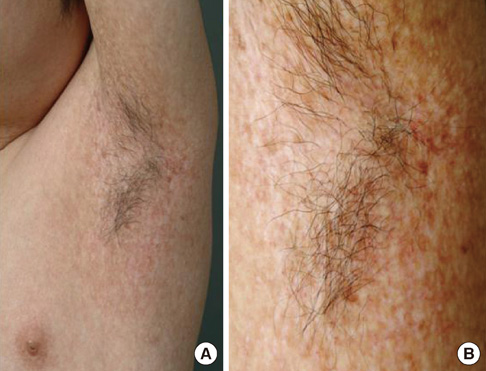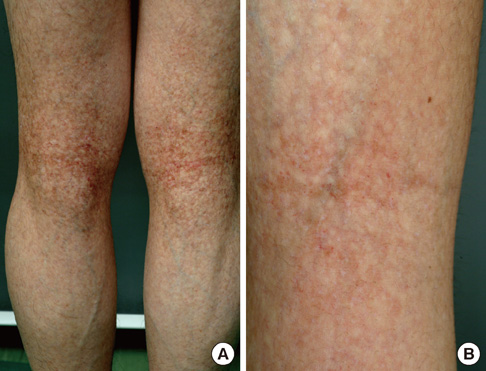J Korean Med Sci.
2012 Feb;27(2):225-227. 10.3346/jkms.2012.27.2.225.
Hereditary Sclerosing Poikiloderma
- Affiliations
-
- 1Department of Dermatology, College of Medicine, Yeungnam University, Daegu, Korea. dhshin@med.yu.ac.kr
- KMID: 1120165
- DOI: http://doi.org/10.3346/jkms.2012.27.2.225
Abstract
- Hereditary sclerosing poikiloderma (HSP) is a very rare disease. The clinical features are principally widespread poikiloderma and linear hyperkeratotic and sclerotic bands. We report an 18-yr-old male who presented reticular hyperpigmented lesions on the trunk and extremities since 2-yr-old. Also, linear sclerosing bands appeared on both antecubital and popliteal fossae after yr. Histopathologic finding showed dense sclerotic collagen fibers with telangiectasia in the upper dermis and fragmentations of damaged elastic fibers in the elastic stain, consistent with HSP. We report the first Korean case of HSP.
Keyword
MeSH Terms
Figure
Reference
-
1. Weary PE, Hsu YT, Richardson DR, Caravati CM, Wood BT. Hereditary sclerosing poikiloderma. Report of two families with an unusual and distinctive genodermatosis. Arch Dermatol. 1969. 100:413–422.2. Greer KE, Weary PE, Nagy R, Robinow M. Hereditary sclerosing poikiloderma. Int J Dermatol. 1978. 17:316–322.3. Grau Salvat C, Pont V, Cors JR, Aliaga A. Hereditary sclerosing poikiloderma of Weary: report of a new case. Br J Dermatol. 1999. 140:366–368.4. Fryburg JS, Sidhu-Malik L. Long-term follow-up of cutaneous changes in siblings with mandibuloacral dysplasia who were originally considered to have hereditary sclerosing poikiloderma. J Am Acad Dermatol. 1995. 33:900–902.5. Walk HK, Hall WD, Hurst JW, editors. Clinical method: the history, physical, and laboratory examinations. 1990. 3rd ed. Boston: Butterworths;Chapter 44 Clubbing.6. Khumalo NP, Pillay K, Beighton P, Wainwright H, Walker B, Saxe N, Mayosi BM, Bateman ED. Poikiloderma, tendon contracture and pulmonary fibrosis: a new autosomal dominant syndrome? Br J Dermatol. 2006. 155:1057–1061.7. Weary PE, Manley WF Jr, Graham GF. Hereditary acrokeratotic poikiloderma. Arch Dermatol. 1971. 103:409–422.8. Blinstrub RS, Lehman R, Sternberg TH. Poikiloderma congenitale. Report of two cases. Arch Dermatol. 1964. 89:659–664.9. Ramachandra L, Rajagopal Shenoi K, Santhosh Pai U. Xeroderma pigmentosa in siblings: cystosarcoma phylloides in a case of xeroderma pigmentosa. Indian J Dermatol Venereol Leprol. 2002. 68:168–170.10. De Boeck K, Degreef H, Verwilghen R, Corbeel L, Casteels-Van Daele M. Thrombocytopenia: first symptom in a patient with dyskeratosis congenita. Pediatrics. 1981. 67:898–903.11. Gottesmann T, Zala L, Vogel A, Mumenthaler M. The Werner syndrome. Schweiz Med Wochenschr. 1980. 110:246–250.12. Young LW, Radebaugh JF, Rubin P, Sensenbrenner JA, Fiorelli G, McKusick VA. New syndrome manifested by mandibular hypoplasia, acroosteolysis, stiff joints and cutaneous atrophy (mandibuloacral dysplasia) in two unrelated boys. Birth Defects Orig Artic Ser. 1971. 7:291–297.13. Fazio M, Lisi S, Amantea A, Maini A, Menaguale G, Sacerdoti G, Balus L. Weary hereditary sclerosing poikiloderma. Ann Dermatol Venereol. 1995. 122:618–620.
- Full Text Links
- Actions
-
Cited
- CITED
-
- Close
- Share
- Similar articles
-
- Two Cases of Poikiloderma of Neck and Chest Treated by Intense Pulsed Light
- Sclerosing hemangioma of lung: 3 case report
- A novel clinical trial for primary sclerosing cholangitis from Asia: All regional endeavors should improve global management of primary sclerosing cholangitis: Editorial on “Safety and efficacy of HK-660S in patients with primary sclerosing cholangitis: A randomized double-blind phase 2a trial”
- A Case of Sclerosing Panniculitis treated with Stanozolol
- Biliary Tract & Pancreas; A Case of Cholangiocarcinoma Suggested as Developing in the Patient with Primary Sclerosing Cholangitis





